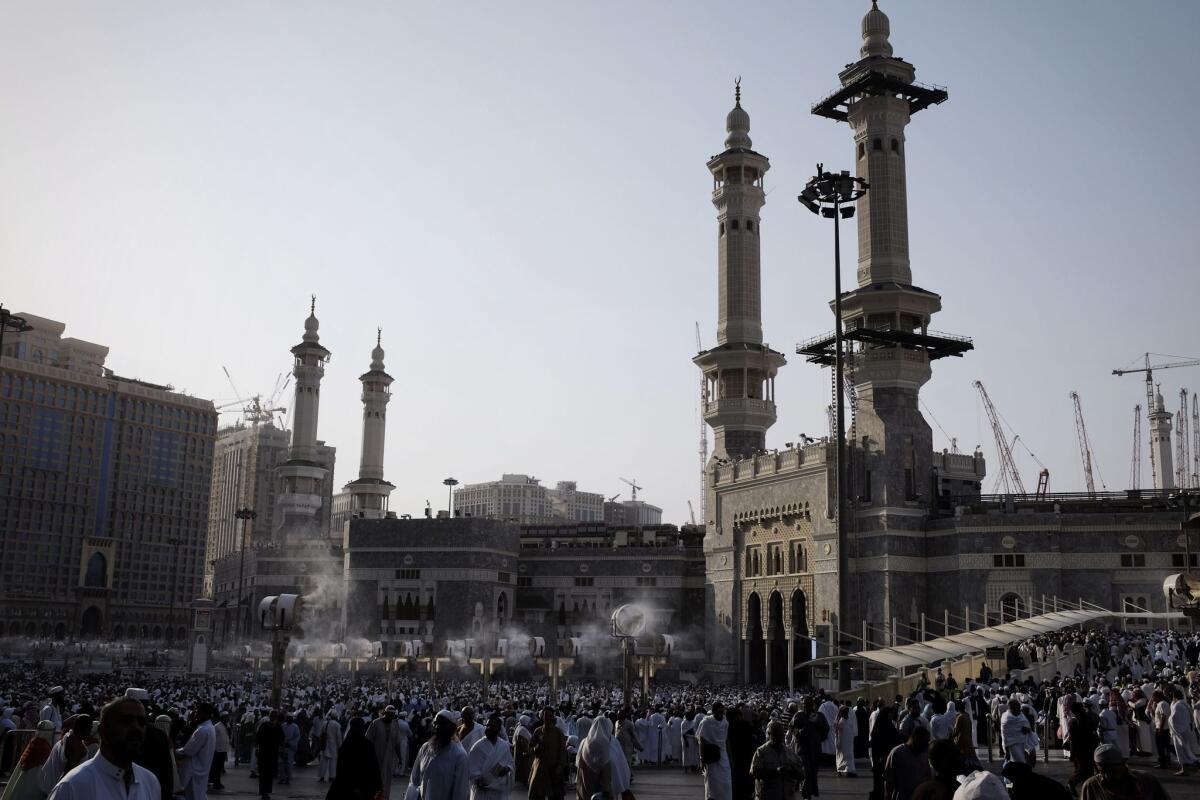‘Selfies’ frowned upon, but technology is transforming the Hajj

- Share via
Technological advances and design engineering at the mosques of Mecca and Medina are promising a safer and more comfortable Hajj experience this year as 2 million Islamic faithful converge on Saudi Arabia.
But much to the dismay of tradition-bound Muslim clerics, a proliferation of smartphones among those affluent enough to make the journey has also encouraged young pilgrims to snap photos of themselves kissing the Grand Mosque’s black stone or taking self portraits with other sacred venues in the background.
“Selfie fever has taken pilgrims and visitors to the two holy mosques by storm in recent days, much to the chagrin of scholars and other pilgrims who condemn such ‘touristy behavior,’” the Arab News observed in an article on the new penchant for documenting the ritual expected of observant Muslims at least once in their lives if they can afford it.
The online news site quoted Islamic Studies teacher Zahra Mohammad of Riyadh as saying that taking a selfie, then posting it on Facebook or other social media, ruined the spirit of modesty and devotion expected during the Hajj.
“Taking such selfies and videos defy the wish of our Prophet,” said Jidda-based scholar Sheik Assim al Hakeem, who deemed the photographing of Hajj rituals contrary to the essence of the pilgrimage that is supposed to be free of “boasting or showing off.”
Scholar Sheik Abdul Razzaq al Badr groused that the kingdom’s decision to relax a ban on cellphones in the mosques, intended to provide pilgrims with a means of seeking help in the event of a crisis, has led to a distortion of the ritual.
“It is as though the only purpose of this trip is to take pictures and not worship. And when they return home they say: ‘Come look at me, this is me on Arafat, this is me in Muzdalifah!’” he observed to Arab News.
Though the new social media role in the Hajj is a matter of debate among the guardians of the faith, Saudi social planners and engineers are being hailed for infusing new elements of protection and comfort into the annual event that has been marred by deadly stampedes, numerous cases of heat stroke and extremist violence. This year’s Hajj is expected to fall between Wednesday and Oct. 7, depending on the sighting of a new moon.
In a photo montage under the headline “10 Ways Engineering Rocks the Casbah,” the Albawaba website displays construction and design improvements and video surveillance that are intended to minimize the hazards incumbent with the Hajj. Those include the hundreds of thousands of pilgrims attempting to walk around the mosques’ interiors, pelting rocks at towers symbolizing the devil and praying on open ground exposed to temperatures that can exceed 120 degrees.
The mataf, the circumambulation courtyard surrounding the Casbah, has been modified as part of Mecca’s Grand Mosque expansion, now capable of “processing” 130,000 pilgrims per hour and is accessible to the disabled, Albawaba noted.
At the Masjid al Nabawi mosque in Medina, 250 giant inverted “umbrellas” have been installed over the courtyard to shade pilgrims from the withering midday sun. In the outdoor assembly area of the mosque, sliding domes have been installed that can be positioned over crowds to protect them from the elements.
The kingdom has also deployed 60,000 security agents and private contractors to protect this year’s Hajj by monitoring facial recognition software and 1,700 closed-circuit cameras.
Saudi health officials have also installed two medical screening points at Jidda airport to check arriving African pilgrims for the Ebola virus to prevent its possible spread to the teeming Hajj sites, the Guardian newspaper of Nigeria reported. Measures have imposed to contain the further spread of Middle East respiratory syndrome, which has killed more than 80 people in Saudi Arabia in the last two years.
A pilot project has provided 300 pilgrims from India’s Chhattisgarh state with free cellphones loaded with an innovative Hajj application that can assist users in locating or messaging one another, navigating the vast sites and translating Arabic. The State Hajj Committee will make the app available to other countries next year, Albawaba said.
The first adopters, though, would be well advised not to use the phones for taking selfies.
Follow @cjwilliamslat for the latest international news 24/7
Sign up for Essential California
The most important California stories and recommendations in your inbox every morning.
You may occasionally receive promotional content from the Los Angeles Times.








